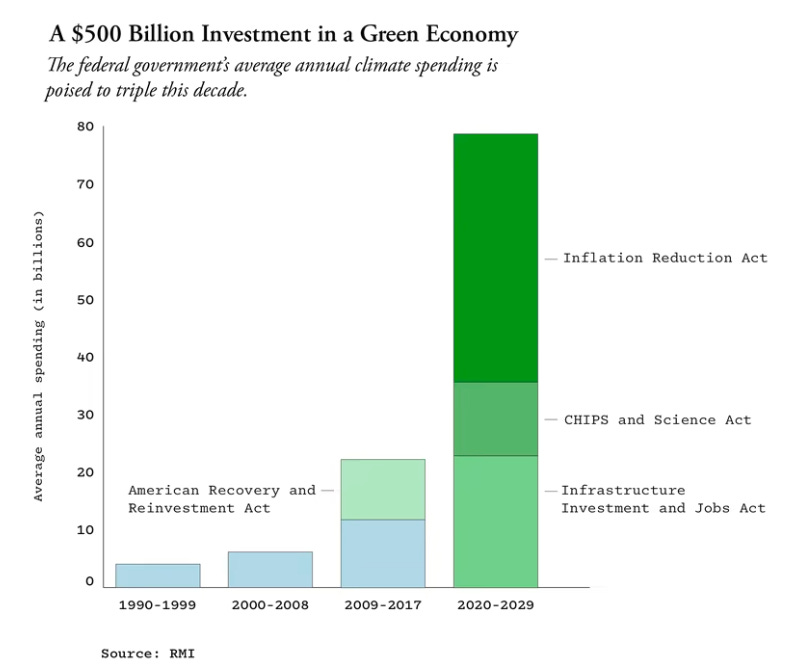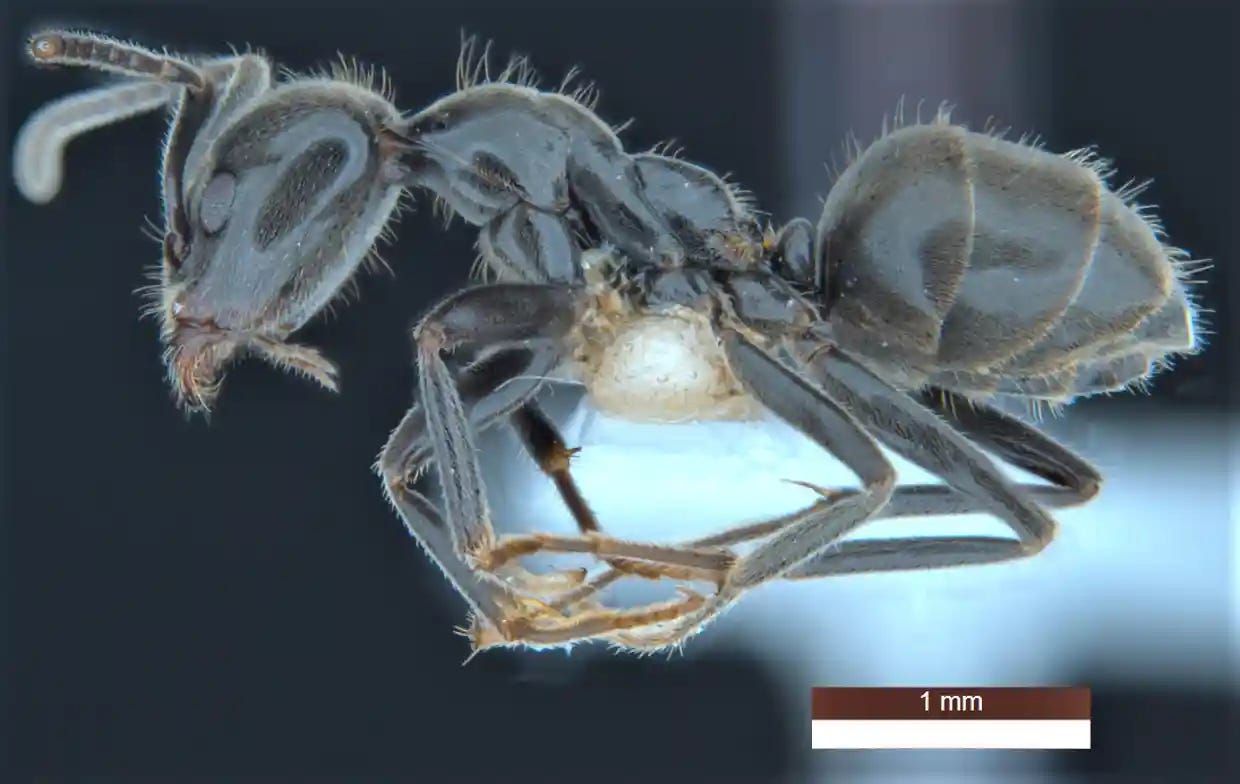The Weekly Anthropocene, August 17 2022
Dispatches from the Wild, Weird World of Humanity and its Biosphere
United States of America: Victory!
$369 Billion in Climate Action Spending
On August 12th, the landmark Inflation Reduction Act, with its magnificent $369 billion in climate action spending (to be disbursed over the upcoming decade), passed the U.S. House of Representatives. (Pictured: Speaker Nancy Pelosi, D-CA). Every single Democrat voted for it, and every single Republican voted against it. Since it's already passed the Senate (see last newsletter’s discussion), and President Biden is eager to sign it into law, this means it’s a done deal. That is incredibly fantastic news!
It’s almost impossible to overstate how big a deal this is. The Inflation Reduction Act is a victory of truly monumental, epoch-making proportions. Before the Biden presidency, the most the US had ever spent on climate action was the $90 billion for renewables (disbursed across the 2010s) in the American Recovery and Reinvestment Act, Obama’s 2009 stimulus bill. Now, between last year’s bipartisan infrastructure bill, the semiconductor-boosting CHIPS and Science Act (signed into law by President Biden on August 9th!), and the immense new Inflation Reduction Act, we’ll be spending almost that much per year for the foreseeable future! (See chart above, from the Rocky Mountain Institute).
There’s so much climate action spending in this bill that it’s beyond the scope of this newsletter to offer a fully comprehensive analysis. But we’ll try! The bill (now certain to be signed into law!) includes (cf. the Senate Dems’ summary and the Bipartisan Policy Center summary):
The biggest section of the bill by far is $161 billion in renewed and expanded clean energy tax credits, making it much easier and more cost-effective to build solar, wind, geothermal, energy storage, and more such low-emissions energy projects. These are all funded through 2032, putting an end to the much-lamented “solar coaster” of uncertainty in federal incentives around renewables projects and allowing developers to move forward in decarbonizing America’s grid with confidence that their projects will be economically viable.
$9 billion in consumer home electrification rebate programs.
$1 billion to make affordable housing more energy efficient.
Nearly $6 billion for a new Advanced Industrial Facilities
Deployment Program to reduce emissions from chemical, steel, and cement manufacturing.
$27 billion for a clean energy technology accelerator, essentially a national “green bank” to fund renewables deployment.
$1.55 billion for EPA work to reduce methane emissions, plus a world-first system of fines and penalties for methane leaks.
A $10 billion investment tax credit to build more clean tech manufacturing facilities, making solar panels, electric vehicles, and wind turbines in America.
$500 million (0.5 billion) to fund Biden’s previous Defense Production Act efforts to boost manufacturing of heat pumps and mining of key minerals.
$2 billion in grants to convert car factories to manufacture electric vehicles.
Up to $20 billion in grants for new electric vehicle factories.
$2 billion for National Laboratories energy research.
$9 billion for federal procurement of American-made clean tech, including $3 billion for electric postal service vehicles.
$3 billion in Environmental and Climate Justice Block Grants, meant to fund helpful community projects in neighborhoods disproportionately harmed by pollution and climate change (more details here).
Another $3 billion in Neighborhood Access and Equity Grants, primarily focused on offering zero-emissions transportation to neighborhoods divided by existing infrastructure barriers.
$1 billion for zero-emissions heavy-duty vehicles, like school buses and garbage trucks.
$3 billion in grants to reduce air pollution at ports
Over $20 billion to support climate-smart agriculture.
Tax credits plus nearly $300 million (0.3 billion) in R&D grants to research sustainable aviation fuel, which could be key in providing seed funding for the nascent industry and build the technological capacity to tackle the hard-to-decarbonize sector of air travel.
$5 billion for forest conservation, wildfire preparation, and urban tree planting.
$2.6 billion to conserve and restore coastal habitats.
Even the giveaways to the fossil fuel industry that were included in the Inflation Reduction Act to secure the vote of coal-loving Senator Joe Manchin (D-WV) will likely cause little to no harm. For example, the bill requires the federal government to hold new auctions for oil and gas leases in some public lands and the Gulf of Mexico, but it looks like no companies are interested in buying-the economic case against new fossil fuel development is just too strong.
“Another transformative bill brought to you by your friendly neighborhood Democratic Party.”-Rep. Hakeem Jeffries, D-NY.
The passage of these climate action investments provides a firm foundation for the renewable energy industry to reach new heights in the 2020s, accelerating America’s and the world’s decarbonization. As we’ve already discussed, early modeling from the Rhodium Group suggests that it will bring us to around a 40% decrease in US carbon emissions below 2005 levels by 2030. The Rhodium Group analysis also estimates that these investments may get up to 81% of America’s electricity from non-fossil fuel sources (renewables plus nuclear) by 2030, and electric vehicles up to 57% of new car sales. Coal burning may drop to 9.7% of US electricity supply by 2030, down from 21.8% in 2021 and over 50% as recently as the 1990s. And early modeling shows that due to reduced air pollution from the switch to renewables, this bill may prevent up to 3,894 premature deaths per year by 2030. Even the worst-case scenario for renewables in American politics from here on out (say, if Republicans take Congress in 2022 midterms and nothing else helpful is passed for years) doesn’t look so bad now: the government is already committed to giving the push needed to turbocharge the clean energy revolution and help set America and the world on a path to cleaner air and a stable climate. And things may well turn out even better! This is really, truly wonderful news.
Massachusetts
On August 11th, outgoing Massachusetts Governor Charlie Baker signed into law a sweeping new climate bill previously passed by the Democratic-controlled Legislature. Notably, Massachusetts has already passed several strong climate laws, including a legal obligation to reach net zero emissions by 2050, and is just adding more and more support to the renewables revolution. The new law is a smorgasbord of good things: among others, it requires that MA utilities procure 5,600 megawatts of new offshore wind power by 2027 (up from the previous goal of 4,000), requires all new cars sold in Massachusetts to be zero-emissions by 2035, pushes the greater Boston bus fleet to go all-electric by 2040, allows ten municipalities to go forward with banning fossil fuel heating in new building (a move previously blocked by state law), allows Massachusetts to jointly bid with other New England states on new renewables projects, makes high-greenhouse gas emissions wood-burning power plants ineligible for renewables subsidies, and sets up new state coordinating and/or research bodies on EV charging and energy storage. Great news!
Michigan
Ford Motor Company has made the largest-ever purchase of renewable energy from an American utility, signing a contract with DTE Energy to add 650 megawatts of new solar power to the grid in Michigan. As a result, by 2025 every Ford vehicle assembled in Michigan will be made with 100% carbon-free electricity. Great news!
New Species: Australia
CSIRO, Australia’s national science agency, has revealed details of 139 new species that its researchers discovered and named in the last year. They include 117 new insects, 11 new spiders, 4 new marine fishes, 3 new plants, 1 new millipede, 1 new earthworm, 1 new marine trematode (a type of parasitic flatworm), and 1 new frog. Highlights include the new millipede, Eumillipes persephone, a blind cave-dweller that is the first millipede species found to actually have over 1,000 legs, and two new eyeless weevil species in the new genus Undarobius, found in the lava caves of Australia’s Undara Volcanic National Park.
Perhaps the most fascinating of these new additions to human knowledge of Earth’s biodiversity is the one species of ant they discovered, Anonychomyrma inclinata (pictured, top). It has evolved to become an “obligate attendant” to a previously known yet rare species: the Bulloak jewel butterfly, Hypochrysops piceatus, meaning that the butterfly cannot complete its reproductive cycle without the ants’ assistance. The butterflies only lay eggs on trees occupied by ant colonies of this species, and when they hatch, their larvae are essentially raised by the ants: protected from predators, guided to soft new tree leaves to feed on, and carried to protected shelters under bark during the winter. To incentivize this behavior, the caterpillars have evolved to secrete a sugary substance described as “ant opium” from a unique gland. (Pictured below: H. piceatus larva in a lab, with A. inclinata in attendance.
“It’s a neat little relationship. [The caterpillar’s gland] appears to have evolved just to feed and appease the ants,” -CSIRO insect expert Dr. David Yeates.
What extraordinary life-forms! As humanity becomes ever more central to the continued life of Earth’s biosphere, we are realizing that we are only beginning to understand the vast and diverse tapestry of beings that share this planet with us. Fascinating news!







